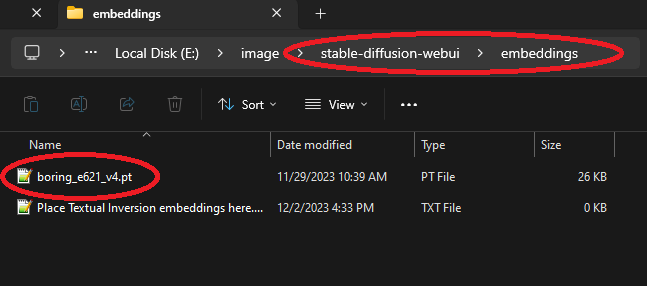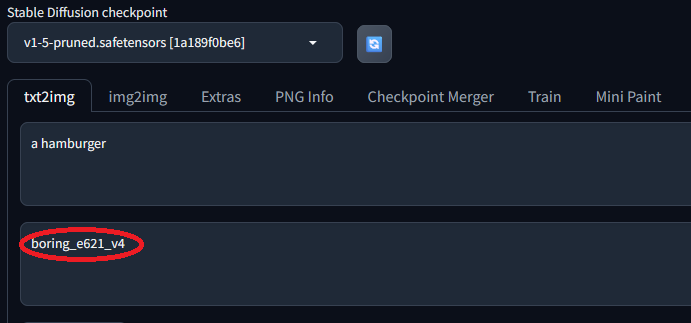title: Boring_Embeddings
tags:
- textual inversion embeddings
- image-generation
- stable diffusion
- AI Art
license: apache-2.0
Boring Embeddings Quick Start
These Stable Diffusion embeddings capture what it means for an image to be uninteresting.
This is useful because it allows you to instruct your model NOT to produce images that look uninteresting.
If you're using the Automatic1111 Stable Diffusion WebUI,
just download one of the pt files into your stable-diffusion-webui\embeddings directory and use
the embedding's name in your NEGATIVE prompt for more interesting outputs.
 |
 |
| Download a .pt file to stable-diffusion-webui\embeddings | Type the embedding's name (without the .pt extension) in your negative prompt |
Model Description
The motivation for Boring Embeddings is that negative embeddings like Bad Prompt, whose training is described here depend on manually curated lists of tags describing features people do not want their images to have, such as "deformed hands". Some problems with this approach are:
- Manually compiled lists will inevitably be incomplete.
- Models might not always understand the tags well due to a dearth of training images labeled with these tags.
- It can only capture named concepts. If there exist unnamed yet visually unappealing concepts that just make an image look wrong, but for reasons that cannot be succinctly explained, they will not be captured by a list of tags.
To address these problems, we employ textual inversion on a set of images automatically extracted from popular art sites
such as e621.net, derpibooru.org, and danbooru.donmai.us. Each of these sites is a rich resource of millions of
hand-labeled artworks which allow users to express their approval of an artwork by either up-voting it or marking it as a favorite.
The Boring embeddings were specifically trained on artworks automatically selected from these sites according to the criteria
that no user has ever favorited them, and they have 0 or only a very small number of up or down votes. The Boring embeddings
thus learned to produce uninteresting low-quality images, so when they are used in the negative prompt of a stable diffusion image generator,
the model avoids making mistakes that would make the generation more boring.
Bias, Risks, and Limitations
- Using these negative embeddings sacrifices some fidelity to the prompt in exchange for improved overall quality. For example, characters in the image may disappear or change eye/skin color.
- Using these negative embeddings may introduce unexpected or undesired content into the image to make it look less boring.
- Unlike other negative embeddings, the Boring embeddings are not intended to fix problems like extra limbs or deformed hands. They can be used alongside other negative embeddings to fix deformities.
Evaluation
To qualitatively evaluate how well the Boring embeddings have learned to improve image quality, we apply them to simple sample prompts using the base Stable Diffusion 1.5 model.
As we can see, putting these embeddings in the negative prompt yields a more delicious burger, a more vibrant and detailed landscape, a prettier pharoah, and a more 3-d-looking aquarium.
Other Models
Boring_e621 has been reported to work well with SD 1.4 or 1.5 models such as:
- https://civitai.com/models/18208?modelVersionId=68551
- https://civitai.com/models/12979/lawlass-yiffymix-20-furry-model
- https://civitai.com/models/4698/lawlass-yiff-mix
- https://civitai.com/models/15503/kavka-mix
- https://civitai.com/models/17649/bb95-furry-mix
- https://huggingface.co/Doubleyobro/yiffy-e18 . This was the fine-tuned model used to train boring_e621.
